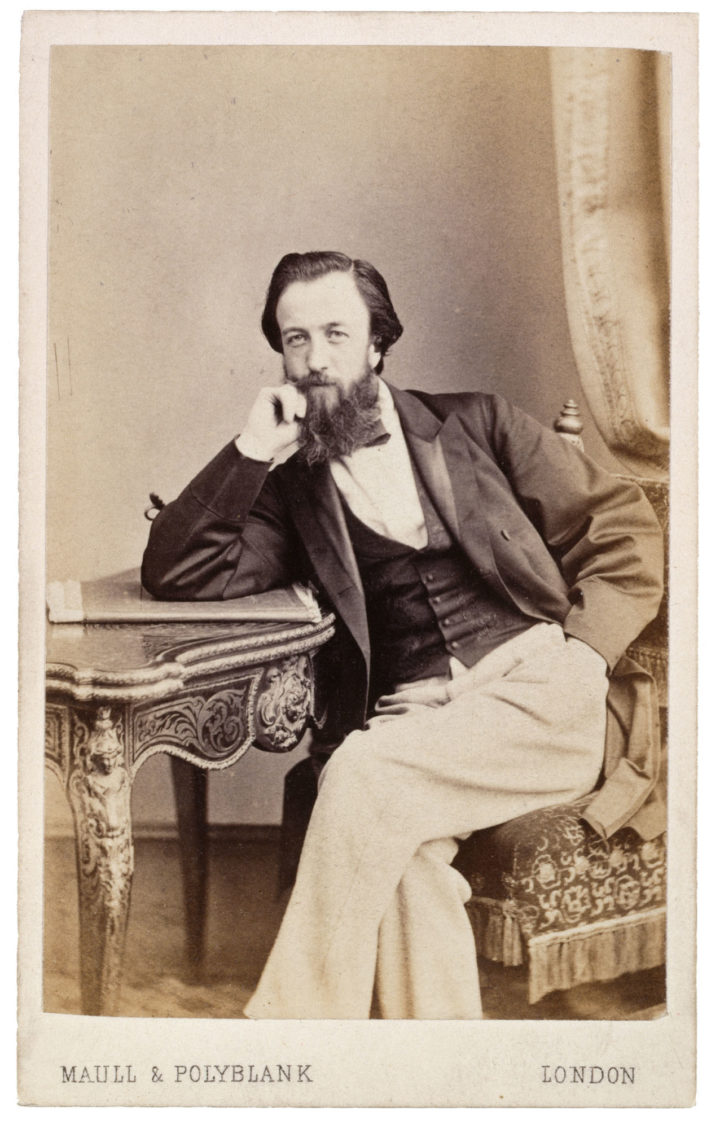The Photographic Portraits Collection
Smile! Digital Assets Manager Andrea Deneau looks at our collection of photographic portraits
Published on 19th November 2021
Neatly labelled and individually packaged in 7 ½ x 5 inch (19 x 12.7 cm) envelopes are at least 624 small, mainly sepia or black and white photographs that belong to the Society’s somewhat underused Photographic Portraits (PP) collection. These photographs all represent Linnean Society Fellows from the early days of photography to the late 20th century.

The earliest of these photographs are mainly albumen print cartes de visite, made popular after the 1859 publication of Emperor Napoleon III’s photograph in this format, and only possible once William Henry Fox Talbot lifted his photography patent in 1852. (Incidentally, Fox Talbot was a keen naturalist and correspondent of the Society’s founder, Sir James Edward Smith.) The carte de visite was relatively cheap to produce, and its size (2 ½ x 4 inches, or 6.4 x 10.2 cm) made it easy to share, like today’s business card. In the 1870s, the carte de visite started to be replaced by the larger cabinet print (4 ¼ x 6 ¼ inches, or 11.4 x 15.9 cm).
Around 400 portraits in this collection were produced by the London photography company started by Henry Maull in 1854 with George Henry Polyblank. Maull & Polyblank’s first studio, from 1856, was on Gracechurch Street, EC. In 1857/1858, they opened another studio on Piccadilly, and then a third studio on Fulham Road, SW in 1864/1865. Polyblank left the partnership in 1865, and from 1866, the company was known as Maull & Co, and from 1879, the company was known as Maull & Fox. Although the partnership between Maull and John Fox was dissolved in 1885, the company continued as Maull & Fox under John’s son until around 1914.
But why bore you with these names, dates, and places? The reason is this: the records for many of our photographic portraits do not have dates, but with the known dates of the various studio locations and name changes of Maull’s company, we can get very good date estimates of many of these photographs. The photographers dutifully stamped the backs of all of their cartes de visite and cabinet prints with the locations of the studios and the company name.

For instance, this carte de visite of Scottish geologist Charles Lyell (left) can be dated between 1857, when the Piccadilly studio was opened, and 1864, before the Fulham Road studio was opened.

Our undated portrait of Richard Owen (right), however, must have been photographed in either 1864 or 1865, as it also lists the Fulham Road studio, but still bears the name Maull & Polyblank, with the stamp changing to ‘Maull & Co’ from 1866.

It is unclear whether the Society had a formal arrangement with Maull’s photography studios. Certainly, they were not the only source of our photographic portraits, as evidenced by Alfred Russel Wallace’s, done by photographer Florence Chant (1857-1930). However, it certainly seems as though the Society tried to drum up as much business for Maull as possible, perhaps not to everyone’s liking. A letter written to a Fellow, W.G. Ridewood, on 17 May 1911 from Maull & Fox, invites him to sit for a portrait ‘in order that an approved likeness of [him] may be added to the Collection kept by the Society’. (BL/5/13) Ridewood then writes to the President of the Society, none too impressed: 'Will you please inform me if the Linnean Society has at any time consented to the use of its name and status by the photographic firm “Maull & Fox” for the purpose of touting for custom by means of circulars such as that which I enclose herewith'. (BL/5/18) Most of our PP records indicate that the portraits were donated ‘by the sitter’. So while the Society may have nudged them to Maull’s studios, it seems the photographs were done at a cost to the Fellows.

Our most-requested Photographic Portrait? Scottish designer Christopher Dresser (1834-1904). This one was taken in 1864 or 1865, if we go by the Maull & Polyblank studio location dates.
The practice of collecting studio photographs of Fellows has long since ended, but newly admitted Fellows are photographed shaking hands with the President and signing the Admissions book during their admission ceremony.
Andrea Deneau, Digital Assets Manager
It should be noted that the Photographic Portrait (PP) collection can be found on the Library Catalogue.
Thank you to my colleagues, Leonie Berwick, Isabelle Charmantier, and Will Beharrell for pointing me in the right directions.
Sources
Linnean Society Archive Catalogue, http://www2.calmview.co.uk/Linnean/Default.aspx, accessed 18/11/2021.
Linnean Society Library Catalogue, http://linnlibrarycat.cirqahosting.com/, accessed 18/11/2021.
National Portrait Gallery, https://www.npg.org.uk/, accessed 18/11/2021.
Parliamentary Archives, UK Parliament, https://archives.parliament.uk/, accessed 18/11/2021.
Royal Academy of Arts, https://www.royalacademy.org.uk/, accessed 18/11/2021.
Royal Society Picture Library, https://pictures.royalsociety.org/home, accessed 18/11/2021.
Wikipedia, https://en.wikipedia.org/wiki/Main_Page, accessed 18/11/2021.
Woollett, C., ‘The Maull Photographic Portrait Collection Held at the Royal Society’, Notes and Records of the Royal Society of London, Vol. 61, No. 1 (2007), pp. 69-74.
